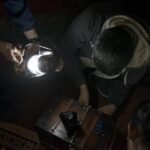THe MacLeod Tartan, steeped in Scottish history, proudly bears the MacLeod Tartan, a vibrant image of resilience and background characterised by way of its vivid yellow and black assessments with pink lines. Originating from the Isle of Skye, this tartan not simplest marks the clan’s identification but also displays the rugged landscapes and tumultuous seas of Scotland’s western isles. Historically extensive, the MacLeod Tartan was worn in battle and at clan gatherings, reinforcing cohesion and distinguishing extended family participants. Today, it remains a staple at cultural activities like weddings and Highland games, connecting current MacLeods to their ancestral roots while additionally taking pictures the imagination of a worldwide target audience. Its adaptability to modern fashion guarantees the tartan stays a loved emblem of Scottish background, symbolizing a bridge among the past and present.
Origins of MacLeod Tartan
Legend has it that the roots of MacLeod tartan Highlander can be traced back to the Norse sea kings, with mythical tales surrounding its beginnings. The lore speaks of heroic ancestors and their epic adventures, contributing to the mystique that shrouds the clan’s early years.
In the 14th century, Malcolm MacLeod of Glen Elg faced a savage bull on his way home from a secret meeting. He killed it, using its horn to create a drinking cup named after Rory Mor, a famous MacLeod chief. Another MacLeod chief displayed bravery by saving a man from a bull in Inverary, leading to the incorporation of a bull’s head crest and the motto “Hold Fast” into the MacLeods of Harris’ armorial bearings. This crest was later memorialized in St Clement’s Church at Rodil, Harris. The black bull’s head symbolizes ancient royalty and the defeat of enemies, with parallels to ancient Egyptian rituals.
History of MacLeod Tartan
Olaf the Black was the Norse King of Man and the Isles who lived in the early 13th century. Leod was his younger son who, around 1220, married the daughter and heiress of MacRaild on Skye. She brought him Dunvegan Castle, and, when his father died, he inherited the islands of Lewis and Harris The MacLeod tartan has weathered centuries of challenges, from times of abundance to scarcity, from conflicts with neighboring clans to sweeping social, political, and economic transformations in the Highlands and Islands. However, it wasn’t until the last century that the dispersed clan members began to reunite under the leadership of their Chief, Dame Flora.
She encouraged her fellow clanspeople to reestablish connections with their ancestral lands. This effort culminated in the inaugural Clan MacLeod Parliament in 1956, graced by the presence of Her Majesty the Queen. Since then, these clan gatherings have been a tradition at MacLeod Castle, drawing MacLeod descendants from across the globe every four years to commemorate their shared heritage.
The iconic Dunvegan Castle, situated on Skye, has been the ancestral seat of the MacLeods for over 800 years and stands as a testament to their enduring presence and influence in the region.
Clan Macleod Tartans
Clan MacLeod tartans, with their distinctive patterns, have transcended mere textile to become iconic symbols deeply embedded in Scottish culture. These tartans serve as vivid representations of the clan’s identity, each pattern narrating a unique aspect of their storied past. Delving into the origins, variations, and uses of these tartans offers insights into the clan’s rich history and their enduring significance. From the bold blues and greens of the MacLeod Harris to the vibrant reds of the MacLeod Lewis, each variation not only beautifies but also signifies the geographical and historical distinctions within the clan. These tartans are utilized in a multitude of ways, from traditional kilts and ceremonial garb to modern fashion items, each use reinforcing the clan’s presence and heritage in both Scotland and the global diaspora.
Clan MacLeod of Harris Tartan
The MacLeod Harris tartan, instantly recognizable within the Clan MacLeod network, is celebrated for its placing aggregate of ambitious blue and inexperienced colors, crisply intersected via sensitive traces of white and black. This tartan is steeped inside the wealthy history of the clan and embodies a extensive cultural history. It is frequently chosen for wear throughout ceremonial activities, wherein it acts as a colourful image of solidarity and delight some of the MacLeod descendants. The prominence of the MacLeod Harris tartan at such occasions underscores its significance and reverence inside the clan, serving not best as a garment but additionally as a testament to their enduring legacy and the deep-rooted identity shared via its contributors.
Clan MacLeod of Lewis Tartan
The Clan MacLeod of Lewis Tartan affords a shiny tapestry of crimson, inexperienced, and blue hues, enriched with tricky traces and complex patterns that deliver each elegance and a deep feel of tradition. This tartan, related to the MacLeod Lewis department, holds a loved region inside the clan, especially well-known for its aesthetic enchantment and the craftsmanship concerned in its design. It is a famous desire for formal occasions, symbolizing the clan’s ancient depth and the strong bonds that unite its individuals across the globe. The MacLeod Lewis tartan is not simply a piece of cloth; it’s far a image of historical past that consists of with it the testimonies and honor of the clan, proudly worn by means of its individuals at gatherings and substantial activities to rejoice their collective identification and historical continuity.
Clan MacLeod’s Territory
Clan MacLeod ruled the wild, mountainous, and enormously beautiful islands inside the northwestern fringe of Scotland, including Skye, Lewis, Harris, and Raasay. These rugged and picturesque islands served as the ancestral place of origin of the extended family, wherein they mounted their strongholds and exerted their affect over centuries.
Descended from seafaring Norse Kings, the MacLeods boast a rich clan records that stretches lower back over 800 years. Their connection to those islands runs deep, reflecting their seafaring background and resilience in navigating the challenges of their ambitious environment. Today, those islands continue to undergo the indelible imprint of Clan MacLeod, serving as a testament to their enduring legacy and the natural splendor of Scotland’s panorama.
What made MacLeods tartan stand out in history?
Clan MacLeods carved a distinct legacy throughout the a long time. Notably, their valor and guardianship of their territories earned them renown as ambitious warriors. Their fearless prowess and martial expertise fashioned pivotal moments in history, from pivotal roles inside the Jacobite risings to conflicts with rival clans. This unwavering dedication to family and land solidified their formidable reputation.
Yet, their influence extended a ways beyond the battlefield. Clan MacLeods left an indelible mark on lifestyle and the humanities, boasting a vibrant tradition of poetry, song, and storytelling. Among their precious possessions is the mythical Fairy Flag, steeped in folklore and respected as a robust brand of their ancestral background.

Famous MacLeods Throughout History
The clan boasts a lineage of remarkable individuals who have left an indelible mark on history. Their contributions, whether in the realms of politics, literature, or warfare, showcase the diversity of talents within Clan MacLeod.
- Sir Rory Mor: Notable for his leadership in the Battle of Harlaw in 1411.
- Norman MacLeod: Renowned minister of St. Columba Church in Glasgow, known for his influential sermons.
- Iain Crichton Smith: Celebrated author and poet, capturing the essence of Scottish life in his works.
- Martyn Bennett: Visionary composer and musician, blending traditional Scottish melodies with contemporary sounds.
- Dr. Anne MacLeod: Pioneer in genetics, making significant contributions to the understanding of hereditary diseases.
- Colin MacLeod: First Scottish cyclist to compete in the Tour de France, showcasing athletic prowess.
MacLeod Tartan Today
While rooted in history, MacLeod tartan continues to evolve, adapting its traditions to the demands of the modern world. The dichotomy between preserving ancient customs and embracing contemporary lifestyles shapes the identity of the clan today.
Cultural Influence
The impact of Clan MacLeod extends beyond familial ties, seeping into the cultural tapestry of Scotland. Art, literature, and music endure the imprints of the extended family, adding depth to the nation’s artistic landscape.
Art: The renowned MacLeod artist, Margaret MacDonald, is widely known for her contributions to the Glasgow Style movement, which drastically impacted the art global inside the overdue nineteenth and early 20th centuries.
Literature: Sorley MacLean, a outstanding MacLeod poet, is hailed as one of the finest Scottish Gaelic poets of the 20 th century, together with his works exploring topics of identity, politics, and the herbal global.
Language: The MacLeod dialect, with its distinct cadence and vocabulary, has influenced the wider Scottish linguistic landscape, maintaining particular linguistic features that reflect the extended family’s heritage.
Festivals: The MacLeod Gathering, held every 4 years at Dunvegan Castle, is a colourful birthday celebration of extended family historical past, presenting conventional music, Highland video games, and gatherings of MacLeod descendants from round the sector.
Cuisine: MacLeod culinary traditions, along with the instruction of conventional Highland dishes like cullen skink or stovies, have grow to be imperative to Scottish cuisine, preserving flavors and techniques passed down via generations.
Genealogy and MacLeod Tartan
For many people, tracing their roots inside Clan MacLeod isn’t pretty much coming across circle of relatives records; it is a profound adventure of self-discovery. Genealogical facts act as critical roadmaps, meticulously connecting people to their deep ancestral strains in the clan. These statistics remove darkness from private histories and strengthen a feel of belonging to the storied legacy of Clan MacLeod. If you are eager to delve deeper into this fascinating exploration or wish to connect to the worldwide branches of the Associated Clan MacLeod tartan Societies, greater sources and network links are available on their authentic website.
For those looking to embrace their heritage further, visiting a tartan shop can be an enriching experience, offering tangible connections to the past through Clan MacLeod tartans and other Scottish artifacts.
Conclusion
In conclusion, Clan MacLeod’s story is a fascinating adventure through time, wealthy with ancient intensity and cultural significance. From its legendary origins to the challenges faced these days, the clan’s legacy endures, weaving itself into the colourful tapestry of Scottish records.
Clan MacLeod’s customs and practices are steeped in way of life, supplying a glimpse right into a bygone technology. From ceremonies to rituals, these traditions are the threads that bind the extended family’s past with its gift.
Frequently Asked Questions
What is the distinction among MacLeod and McLeod?
The names Macleod and McLeod may also seem distinctive, but in essence, they’re one and the identical. The Mc in McLeod is an abbreviation for Mac, derived from the Gaelic phrase for “son.”
How can I hint my genealogy within MacLeod tartan?
Several assets, including genealogical databases and extended family archives, can assist in tracing your lineage inside Clan MacLeod.
What is the significance of Clan MacLeod’s crest?
The crest of Clan MacLeod consists of symbols representing the values and records of the extended family, serving as a visible illustration of its identity.
Are there modern-day activities celebrating Clan MacLeod’s background?
Yes, various events and fairs have fun Clan MacLeod’s heritage, offering opportunities for clan participants and lovers to return together.
Can I go to historic sites associated with MacLeod tartan in Scotland?
Absolutely! There are numerous visitor attractions related to MacLeod tartan, presenting a firsthand enjoy of its wealthy records.











